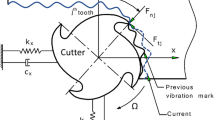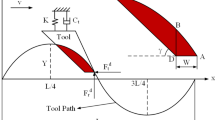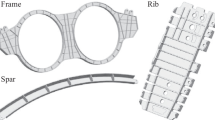Abstract
Process damping generated between the clearance face of the tool and wavy finish workpiece surface has a strong effect on cutting dynamics and stability, especially at low cutting speeds, resulting into higher chatter stability limit. It is particularly important for hard-to-machine materials, such as titanium, nickel super alloys, and hardened steels, which need to be machined at low cutting speed. However, process damping has been mostly ignored in chatter analysis as there is no practical model for estimation of it. In the meantime, the existing studies on the process damping encounter the challenges of computational efficiency. In this study, process damping effect is equivalent to a linear viscous damping which is described by the process damping coefficients. An energy dissipation principle is established to relate the flank-wave indentation area to the process damping coefficients. Two methods are proposed to calculate the indentation area, which is involved in the cutting stability computation and occupies the most time. In analytical integration method, the sinusoidal expression of workpiece surface undulation is fitted by piecewise polynomial to calculate the indentation area. In numerical integration method, the area is realized by summation of the divided small area unit. The time for establishing stability lobes by the above two methods is greatly reduced compared with the detailed method proposed by Ahmadi and Ismail (Int J Mach Tools Manuf 51:296–308, 2011) which took 10 min to compute one single lobe. It demonstrates that the stability lobes established in frequency domain by the proposed methods are extremely efficient. Moreover, the stability lobes maintain enough accuracy compared with stability lobes established for different amplitudes of vibration as reported by Ahmadi and Ismail (Int J Mach Tools Manuf 51:296–308, 2011), especially the finite amplitude stability, with that, the vibration stabilizes at an amplitude between fully stably and fully unstable due to process damping.
Similar content being viewed by others
References
Altintas Y, Eynian M, Onozuka H (2008) Identification of dynamic cutting force coefficients and chatter stability with process damping. CIRP Ann Manuf Technol 57:371–374
Budak E, Tunc LT (2009) A new method for identification and modeling of process damping in machining. J Manuf Sci Eng 131:51019
Tunç LT, Budak E (2013) Identification and modeling of process damping in milling. J Manuf Sci Eng 135:21001
Kurata Y, Merdol SD, Altintas Y, Suzuki N, Shamoto E (2010) Chatter stability in turning and milling with in process identified process damping. J Adv Mech Des Syst Manuf 4:1107–1118
Yusoff AR, Turner S, Taylor CM, Sims ND (2010) The role of tool geometry in process damped milling. Int J Adv Manuf Technol 50:883–895
Peters J, Vanherck P, Van Brussel H. (1971) The measurement of the dynamic cutting coefficient. CIRP Ann Manuf Technol 129–136
Tlusty J (1978) Analysis of the state of research in cutting dynamics. CIRP Ann Manuf Technol 27:583–589
Wu DW (1989) A new approach of formulating the transfer function for dynamic cutting processes. J Manuf Sci Eng 111:37–47
Chiou RY, Liang SY (1998) Chatter stability of a slender cutting tool in turning with tool wear effect. Int J Mach Tools Manuf 38:315–327
Ahmadi K, Ismail F (2011) Analytical stability lobes including nonlinear process damping effect on machining chatter. Int J Mach Tools Manuf 51:296–308
Tyler CT, Schmitz TL (2013) Analytical process damping stability prediction. J Manuf Process 15:69–76
Türkeş E, Neşeli S (2014) A simple approach to analyze process damping in chatter vibration. Int J Adv Manuf Technol 70:775–786
Fu Z, Zhang X, Wang X, Yang W (2014) Analytical modeling of chatter vibration in orthogonal cutting using a predictive force model. Int J Mech Sci 88:145–153
Huang CY, Wang JJ (2007) Mechanistic modeling of process damping in peripheral milling. J Manuf Sci Eng 129:12–20
Chandiramani NK, Pothala T (2006) Dynamics of 2-dof regenerative chatter during turning. J Sound Vib 290:448–464
Jin X, Altintas Y (2013) Chatter stability model of micro-milling with process damping. J Manuf Sci Eng 135:31011
Inman DJ, Singh RC (2001) Engineering vibration. Prentice Hall, Upper Saddle River
Shi HM, Tobias SA (1984) Theory of finite amplitude machine tool instability. Int J Mach Tool Des Res 24:45–69
Ahmadi K, Ismail F (2010) Experimental investigation of process damping nonlinearity in machining chatter. Int J Mach Tools Manuf 50:1006–1014
Altintas Y.(2012) Manufacturing automation: metal cutting mechanics, machine tool vibrations, and CNC design. Cambridge University Press
Author information
Authors and Affiliations
Corresponding author
Rights and permissions
About this article
Cite this article
Cao, C., Zhang, XM. & Ding, H. An improved algorithm for cutting stability estimation considering process damping. Int J Adv Manuf Technol 88, 2029–2038 (2017). https://doi.org/10.1007/s00170-016-8884-x
Received:
Accepted:
Published:
Issue Date:
DOI: https://doi.org/10.1007/s00170-016-8884-x




